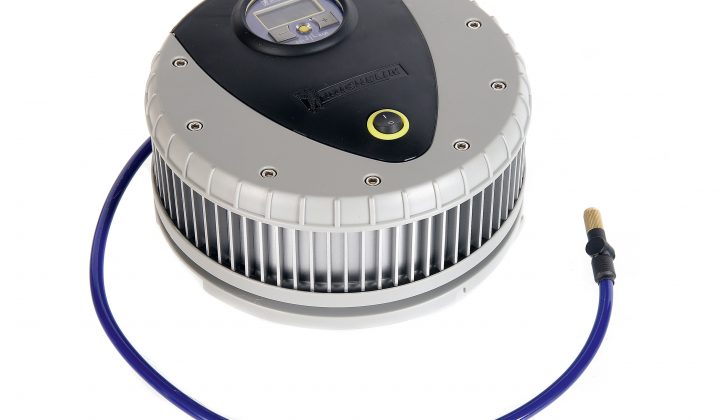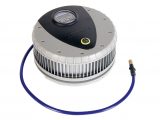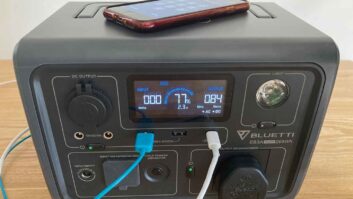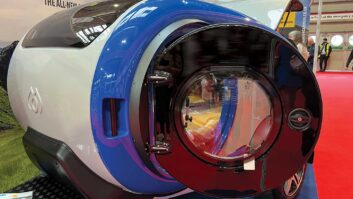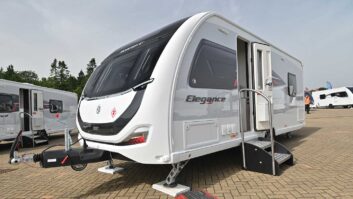Verdict
Priced at an affordable £39.99 (when tested), the Practical Caravan test team award the Michelin Hi-Power Rapid Tyre Inflator four stars out of five. It works quickly to inflate tyres, has an auto-stop function and the digital gauge is easy to read, but we’d have liked to have seen a deflate button.
Pros
It has an accurate digital gauge
It works quickly
There’s an auto-stop function
Cons
There’s no deflate button
Few of us would set off on our caravan holidays without first making sure that the caravan and tow car’s tyres were at the correct pressures. Aside from the obvious safety risks of incorrect pressures, there’s also the effect that under-inflated tyres have on fuel economy. Some studies suggest that mpg can fall by as much as 10%, even if tyres are only a couple of PSI below what they should be.
Rectifying tyre pressures can be a tedious job. SUVs or 4x4s make great tugs, but their giant tyres need huge volumes of air if pressures are even slightly low. Using a foot pump is an option, but very tiring when checking six, maybe eight tyres. Clearly there’s a lot to be said for buying a portable, powered tyre compressor to speed up the process and remove the strain – so here at Practical Caravan we conducted a tyre compressor group test.
We began our tests by seeing how quickly each unit could inflate a 205/55 x 16 tyre from flat to 30PSI. During connection, we also appraised how user-friendly the compressors are: long power leads and air hoses make positioning much easier, and cordless operation is better still. We also noticed that some higher power models attach directly to a battery’s terminals, which is an advantage when tackling a caravan’s tyres because of the close proximity of the leisure battery.
The connection between the air hose and the tyre valve varies, too, with screw-on style couplings proving more foolproof and easier to use. Some models also have a deflate button. Being able to deflate a tyre, while monitoring its pressure, is more straightforward than flitting between pressing a valve manually, and then checking the pressure with a gauge. But why would you want to deflate a tyre at all, you may wonder? Well, most tow vehicles’ tyres have to be hardened up prior to attaching a tourer, so after the trip away you’ll want to lower the pressures to where they should be. Also, some of us over-inflate caravan tyres when the van’s not being used, because there’s a theory that this prevents flat spots forming. Whether this is true or not, the tyres will need returning to their correct pressures before the caravan is used on the road.
During this testing process, we checked how accurate each unit’s gauge is and ensured that it can be seen easily when the product is being used – digital gauges are the easiest to read at a glance. Auto-stop technology, which automatically turns off the compressor when the desired pressure is reached, is a big bonus, simply because you can leave the unit to its own devices while you do something else.
Further points were awarded to tyre compressor units with useful extra features. Lights are a bonus, should you have to deal with a low tyre at night. And an integral high-volume low-pressure pump – for rapidly dealing with inflatables – means you won’t need to take a separate pump away with you.
Here we review the Michelin Hi-Power Rapid Tyre Inflator – it this a must-have caravanning accessory? A little Gallic design flair makes this unit better looking than most, and it’s quick, too, taking just 2 mins 32 secs in our pump-up test.
Feature-wise, there’s a super-accurate digital gauge on this Michelin product, plus an auto-stop function. And it’s hard not to be impressed by the bright lights that ping on whenever the unit’s plugged in. In an emergency situation, at night, they could make all the difference. We like the screw-on valve coupling but, at this price level, a deflate button would have been nice, as would a leisure inflator/deflator.
We tested a range of products and the overall winner, receiving a five-star review, was the Halfords Multi-Purpose Inflator. You might also like to read what we thought of the Ring RAC900, the Draper 65958 and the T-Maxx Portable Compressor.
There’s a super-accurate digital gauge, plus an auto-stop function
